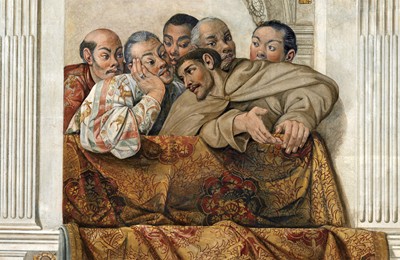
I start with this series, a story that is, for me, spectacular. It is the Keichō embassy.
This diplomatic mission was led by the samurai Hasekura Tsunenaga in 1613 and was Japan's first official embassy to Spain and Rome.
Its main purpose was to establish trade and diplomatic relations with Spain and the Vatican on behalf of the daimyo Date Masamune, lord of Sendai.
Masamune hoped to open direct trade routes with Spain and to seek support for Christianity in Japan, which was then facing intense persecution under the Tokugawa shogunate.
The embassy travelled across the Pacific and Atlantic Oceans, and although it did not achieve its commercial goals, it left a significant cultural impact and set a precedent in Japan-West relations.
My story begins here. A member of the Keichō embassy impresses, enamours and impregnates a woman in Coria del Río and her son, when his mother dies of malaria, tries to find his origins in Cipango (Japan). The journey by sea from Spain to Japan and their experiences of two different cultures are intended to make an exciting travel chronicle.
I hope you like it.
Any comments?
To be continued
Header Image:
Portrait of Hasekura Tsunenaga in the Salone dei Corazzieri at the Palazzo del Quirinale in Rome, 1616
Qué valiente eres, @druida, ahora una de galeones y monedas de plata (y sin Biodramina) : )
Espero no morir en el intento…es una historia que tiene que ver más con los descubridores de las rutas marinas para unir culturas que con las monedas de plata: Andrés de Urdaneta, por ejemplo. A ver cómo lo hago. Tengo un andamiaje un poco inestable todavía.
It seems like this will be an exciting story.
Es todo un proyecto de "alta mar". Yo ya me perdí con Shogun, : DDD pero me gustan las historias de barcos. A ver si puedo seguirte sin "quemar" el diccionario. : D "May the winds be ever in your favor!"
When I was younger, I was very interested in Date Masamune and have read about him, but I didn't know that the guy you start writing was his embassy. This is new to me. I'm thrilled to read your new series! And, I love you put a Japanese term of summary, あらすじ
I'm glad you like it, Yumi ( @yumiyumayume ) . This Japanese embassy was a feat, and usually from a Western perspective much of Eastern culture is unknown. Yes, each title will have a Japanese word that sums up the episode. It's a challenge for me because I don't know Japanese. I hope to do well with the dictionaries on the Internet.
I am a storyteller and with the apology of writing about something, I am improving my English skills. Comments, responses and feedback on the written texts are the ‘icing on the cake’. I hope you like it , Shirley ( @SEQ77 ).
I had never heard of this so should be educational for me.
Interesting. Will this be "semi-fiction" or an attempt or actual history? (It might be good to let readers it is a semi-fictional work.)
Very interesting. I didn't even know about Coria del Río until I read this. I love the book Shogun and the show. Good one! My only comment would be that writing in italics limits your expression because if everything is italicized, how do you emphasize anything? Also, in literary works, italics are used for forethoughts, side thoughts and afterthoughts.
It will be a story of semi-fiction, T Newfields ( @T-Newfields ). The historical setting will be real but the characters will be fictitious and dramatised. I think that, perfectly well, the latter could also be real.
I hope you find it useful and interesting as well, @Sprouts .
As an anecdote, I will tell you that part of the Japanese embassy stayed in Coria del Río. Their descendants have the surname ‘Japón’. Can you imagine an Oriental speaking with an Andalusian or Cuban accent? As for the improper use of italics, you are right. I will stop using it. Thank you very much, Uly ( @CocoPop ). .
😂